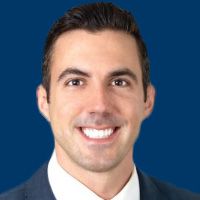Neoadjuvant Abemaciclib Active in HR+/HER2- Breast Cancer
A neoadjuvant regimen combining the CDK4/6 inhibitor abemaciclib with anastrozole induced a response rate of 54.7% in patients with HR+/HER2-negative early-stage breast cancer, according to findings from the phase II neoMONARCH trial.
Sara A. Hurvitz, MD
A neoadjuvant regimen combining the CDK4/6 inhibitor abemaciclib with anastrozole induced a response rate of 54.7% in patients with HR+/HER2-negative early-stage breast cancer, according to findings from the phase II neoMONARCH trial presented at the 2016 San Antonio Breast Cancer Symposium.
The study also met its primary endpoint of reduction in Ki67 expression level at week 2. The abemaciclib combination yielded a geometric mean change in Ki67 from baseline to day 15 of -92.6%.
“The majority of patients who received abemaciclib and anastrozole experienced an objective response. These data support continued evaluation of abemaciclib in patients with early-stage breast cancer,” said lead study author Sara A. Hurvitz, MD, associate professor of medicine at UCLA, and medical director of UCLA’s Jonsson Comprehensive Cancer Center Clinical Research Unit.
The phase II neoMONARCH trial included 223 women with HR+ HER2-negative early-stage breast cancer (stage I [≥ 1 cm)], II, IIIA, or IIIB). Patients underwent a core biopsy at baseline and were then randomized 1:1:1 to monotherapy with anastrozole (1 mg daily) or abemaciclib (150 mg every 12 hours), or a combined regimen of the 2 drugs at the same doses. Prophylactic loperamide (2 mg) was administered with each dose of abemaciclib for the first 28 days and then at the physician’s discretion thereafter.
Patients received treatment for 14 days and then a second core biopsy was done. After the day 14 biopsy, all patients went on to receive combination therapy with anastrozole and abemaciclib for 14 weeks, at which point another biopsy was performed, followed by surgery (optional) in some patients.
Ki67 levels were measured in a central laboratory at USC, and patients must have had a Ki67 level at baseline of >5% to be evaluable. Hurvitz explained the rationale for using Ki67 expression as the primary endpoint.
“Other studies have indicated that Ki67 change from baseline to 2 weeks after hormonally targeted therapy may be predictive of disease-free survival. For this reason, we defined our primary endpoint as change in Ki67 from baseline to 2 weeks of therapy,” said Hurvitz.
The geometric mean change in Ki67 expression was -63.2, -90.6, and -92.6, for the anastrozole alone, abemaciclib alone, and combination arms, respectively. “Both of the abemaciclib arms were significantly greater in terms of their yield change compared to anastrozole, with a P value of <.001,” said Hurvitz.
With complete cell cycle arrest, defined as a Ki67 of <2.7% at day 15, the abemaciclib-based arms significantly improved the achievement of complete cell cycle arrest compared to anastrozole alone.
“Abemaciclib induced profound cell cycle arrest, defined by decreased Ki67 and E2F targeted proliferation mRNAs, and reduction of expression of genes associated with senescence [RRM2 and FOXM1],” said Hurvitz.
“Treatment with abemaciclib in combination with anastrozole may induce immune cell infiltration, characterized by an increase in total T cells and cytotoxic/suppressor T cells,” she also noted.
The ORR data Hurvitz reported combined all 3 trial arms because, “All patients received 14 weeks of combination therapy with abemaciclib an anastrozole,” Hurvitz explained. Among 106 patients across the 3 study arms who completed treatment, radiologic ORR was 54.7% and caliper response was 56.6%.
At the time of the analysis, a pathologic complete response was achieved by 3.2% of the 95 patients who underwent surgery. There was 1 patient who discontinued treatment at week 12 due to progressive disease.
Safety data were reported for a population of 223 patents treated across all 3 treatment arms. The most common all-grade adverse events (AEs) included diarrhea (55.2%), constipation (39%), nausea (36.8%), fatigue (35%), abdominal pain (19.7%), decreased appetite (18.4%), vomiting (12.1%), and hot flush (11.7%).
All-grade laboratory abnormalities included increased creatinine (95.9%), decreased neutrophil count (66.7%), WBC decrease (61.6%), ALT increase (42%), AST increase (28.3%), anemia (17.7%), and platelet count decrease (15.1%).
There were no grade 4 AEs. Grave 4 laboratory abnormalities included neutrophil count decrease (0.9%) and WBC decrease (0.5%).
In comparing abemaciclib with other successful CDK4/6 inhibitors in breast cancer, Hurvitz said, “This is a fairly unique drug, in that it can be given continuously, so we do not need to take a 1 week or more break every month with this therapy in order to allow neutrophil recovery. The other 2 drugs in this class (palbociclib and ribociclib) thus far have been developed using a 3-week-on, 1-week-off regimen. [It has been theorized that] during that 1 week off, there could be a rebound in cell-cycling that may actually promote resistance to the therapy.”
Hurvitz S, Martin M, Abad MF, et al. Biological and clinical effects of abemaciclib in a phase 2 neoadjuvant study for postmenopausal patients with HR+, HER2- breast cancer. Presented at: 2016 San Antonio Breast Cancer Symposium; December 6-10; San Antonio, TX. Abstract S4-06.
<<<
View more from the 2016 San Antonio Breast Cancer Symposium
Grade 3 AEs and laboratory abnormalities included decreased neutrophil count (7.3%), ALT increased (4.6%), diarrhea (4%), constipation (1.3%), nausea (2.2%), fatigue (1.3%), abdominal pain (3.1%), decreased appetite (1.8%), vomiting (0.9%), AST increase (2.3%), creatinine increase (1.4%), and WBC decrease (2.7%).



